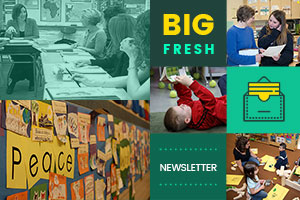A little candy now and then is relished by the wisest men.
—Roald Dahl
Sweet Reads & Treats
We’re heading into the end of the calendar year, and many of us get the gift of a winter vacation. Although your calendar may be stuffed, my hope is there is a little space for some winter reading.
This issue is perfect for those looking to add a graphic novel or novel in verse to their TBR stack in the next few weeks of winter. Not only that, but contributors offer wise advice for using these texts in our classrooms.
And while you’re making room for some sweet reading time, may I also invite you to make some space for this simple 15-minute luxury: Saltine Toffee. It’s a recipe from my childhood.
Preheat the oven to 400 degrees. Take a cookie sheet and line it with foil that hangs over the edges. Top it with parchment paper. (This might be unnecessary, but I use both for easy cleanup.) Fill the cookie sheet with a single layer of saltine crackers. It feels good to line them all up just right.
In a medium saucepan melt one cup of unsalted butter and one cup of dark brown sugar. (You can use regular brown sugar and salted butter, if that’s what you have on hand…Margarine will also work in a pinch.) Stir until it boils. Once it is boiling—really boiling…the kind that it spits little bits out and stings your hand—set the timer for three minutes. Stir and boil while your timer counts down.
Then drizzle it all on top of the crackers. You might have to spread it around to cover every bit of the crackers.
Bake for 5-6 minutes. Remove from oven and sprinkle with two cups of chocolate chips. I use dark chocolate or semi-sweet or milk or white…whatever the mood dictates, but always fair trade. Wait a couple of minutes and then use a knife to spread the chocolate over every inch of the crackers.
Sprinkle with whatever you love—pecans, toasted coconut, toffee bits, sprinkles. Add a little sea salt to take it to the next level. Then let it cool. (Go read your book.)
Once you’ve finished a few chapters and the toffee has cooled, break it into bite-sized pieces. Put it in a sealed container. Rumor has it that this will last about a week on your counter…but it never lasts more than a couple of hours around here.
Shine on,
Ruth Ayres
Editor in Chief

Christy Rush-Levine makes a case for the robust nature of reading graphic novels. Included are two downloads: a classroom library permission slip and an initial reader’s notebook entry form.
Andrea Smith shares the value of free-range learning in helping students explore nonfiction with a focus on maps.
If you are looking to increase the quantity and quality of graphic novels for your learners in your classroom library, Shari Frost has a booklist to get you started.
There is so much information bombarding us about teaching readers that it is easy to feel overwhelmed and frazzled. Tammy Mulligan has a deep knowledge of the science of reading and the practical experience of growing readers in her own classroom. Tammy just released a new book that we all need. Check out a free sample of Tammy’s new book, The Power of Quick and Frequent Practice: Joyful Small Moves with Big Impacts on Elementary Literacy.
 PS: May we just linger in the beauty of the cover and the artwork from one of Tammy’s former students? You will not regret opening this book. It is a masterpiece from an educator who has spent a long career learning to teach directly to the point of each student’s need. She teaches well…not just the students in her classroom, but adults, too…those of us who need this book to teach with deep love and wisdom in our own classrooms.
PS: May we just linger in the beauty of the cover and the artwork from one of Tammy’s former students? You will not regret opening this book. It is a masterpiece from an educator who has spent a long career learning to teach directly to the point of each student’s need. She teaches well…not just the students in her classroom, but adults, too…those of us who need this book to teach with deep love and wisdom in our own classrooms.

New members-only content is added each week to the Choice Literacy website. If you’re not yet a member, click here to explore membership options.
Gretchen Schroeder bolsters her students’ reading lives and deepens discussion about theme by using the rich graphic novel They Called Us Enemy as a whole-class read with her high school students. Gretchen shows how teachers can support students in deep literary analysis.
Tara Barnett and Kate Mills offer tips and a booklist to position students to read novels in verse.
In this encore video, Tammy Mulligan leads a demonstration small group with sixth graders who are reading novels in verse.
In this encore video, Tammy Mulligan leads a demonstration small group on finding themes in graphic novels. The lesson includes a prebrief and debrief with the teacher.

New members-only content is added each week to the Choice Literacy website. If you’re not yet a member, click here to explore membership options.
Teacher Educators Teach | Getting writing started is often the biggest challenge for writers of all ages and experiences. Suzy Kaback offers a process called slide decking with her in-service teacher colleagues as a way to plan the content of an essay or article.
We all know when we need to have a conversation that will help but feels tricky to enter. Instructional Coach Mary Brower offers sage advice for navigating conversations with principals.
This PD2Go focuses on intentionally uplifting student voices by pairing an article by Becca Burk and a conference with Dana Murphy.
Quote It:
Kindness is like snow. It beautifies everything it covers.
—Kahlil Gibran
That’s all for this week!



